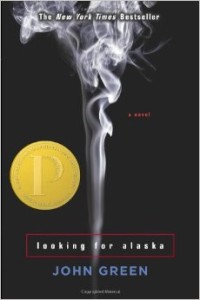Looking For Alaska
by John Green
This entry was created for the Fall 2014 semester by Kristen Kelley.

Author Bio
John Green was born in Indianapolis, Indiana on August 24th, 1977. He grew up in Orlando, Florida and attended Kenyon College in Ohio for English and religious studies. Green then lived in Chicago for several years while writing “Looking for Alaska”. In Chicago, he worked for Booklist, the review journal, reviewing books particularly fiction books about Islam or conjoined twins. “Looking for Alaska” was Green's first novel and was put on the ALA 2005 Top 10 Best Books For Young Adults list, and won the Michael L. Printz award in 2006. Green's other novels include “An Abundance of Katherines” (2006), “Paper Towns” (2008), “Will Grayson, Will Grayson” (2010), which he collaborated with David Levithan, and “The Fault in Our Stars” (2012), which received the number one spot on The New York Times Best Seller List for Children. Green is also well known by his fans for his video blog that he and his brother created on YouTube called Brotherhood 2.0, through which they established a subculture of fans called Nerdfighters who fight for intellectualism and “to decrease the overall worldwide level of suck”. Green and his brother Hank have led the Nerdfighters to raise hundreds of thousand of dollars for charity as well as for projects such as planting trees.
Discussion Questions
1. In your opinion, what do you think the Labyrinth represents?
2. Why is it so important for Pudge and The Colonel to figure out whether Alaska's death was intentional or accidental?
3. Why do you think John Green kept Takumi as such a secondary character up until the last pages of the book?
4. Do you think Alaska's feelings for Pudge were real or were they just a way of escaping her problems, or were they wishfully interpreted by Pudge?
5. Based on the themes of the book that caused it to be challenged, do you think that these themes are harmful or rather are effective in teaching teens lessons about real life issues that they are or will be faced with?

